
5 company merch design tips that’ll help get you noticed
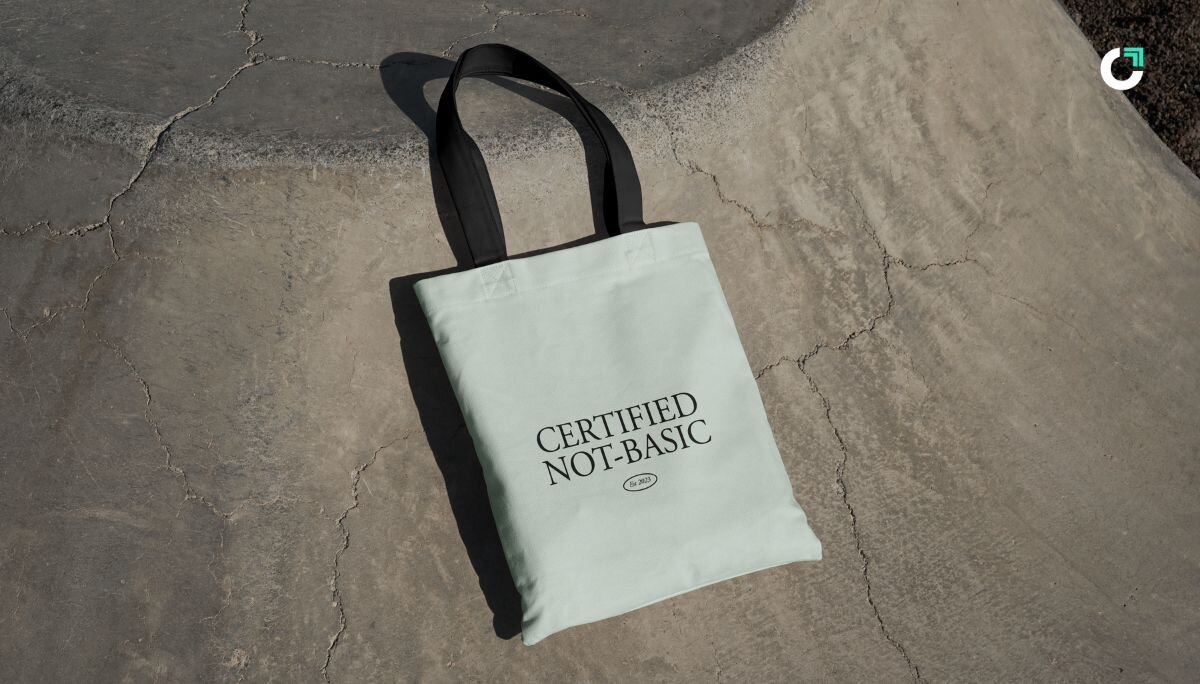
Branded items are everywhere: 53% of people use a promotional product at least once a week, and 81% keep them for over a year. That means your company merch has ample opportunity to become part of someone’s routine.
Yet, many marketers and small business owners take the easy route: plaster a logo on whatever’s cheapest or easiest, and hope it’s good enough for a welcome kit, client thank-you gift, or a conference giveaway. (Spoiler alert: unless it feels like something they personally picked out, nobody wants to be a walking billboard for a brand.)
This is where company merch design makes all the difference. By making deliberate choices around materials, color, silhouette, and branding placement, you increase the odds that someone will not only keep your merch but actually want to use it.
The best part? You don’t need to be a professional designer or artist to get it right. Here are 5 company merch design tips to help your items become keeps, not clutter.
1. Start with your brand vibe, not your logo file
It’s tempting to open a merch catalog, head straight to the “bestsellers” page, and upload your logo onto whatever catches your eye.
But this is how brands end up with generic, forgettable merch. Great company merch design should start with brand expression, not a product. Ask yourself: What do we want this item to say about us? Are we minimalist and clean? Playful and irreverent? Premium and sleek? Outdoorsy and rugged?
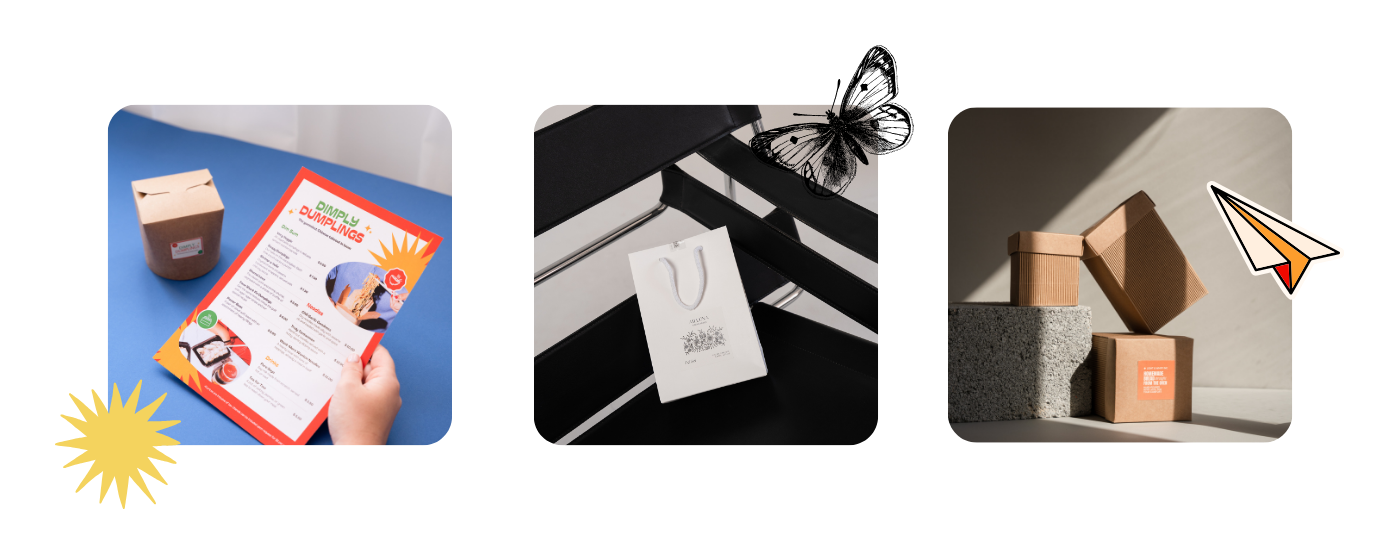
Here’s how this creative direction might translate for different types of brands:
- Budget-conscious or playful startups: Lean into fun, practical, or clever choices that show personality. Think: colorful zipper pouches, UV-printed notebooks with cheeky taglines, or playful bucket bags.
- Eco-conscious brands: Prioritize natural textures and greener materials that reinforce your environmental values, like recycled baseball caps, bamboo tech accessories, cork cover notebooks, or plant-based fiber t-shirts.
- Luxury or premium brands: Choose elevated materials with weight and texture that signal quality from the first touch. Some popular choices here include heavyweight fleece hoodies, matte stainless steel drinkware, luxe blankets, and useful tech accessories.
2. Select decoration methods that reinforce quality
Next, think about how your branding shows up on the item. Not all print methods are created equal, and each carries a different tactile and visual language. A glossy heat transfer on a premium heavyweight crewneck, for instance, can feel out of place.
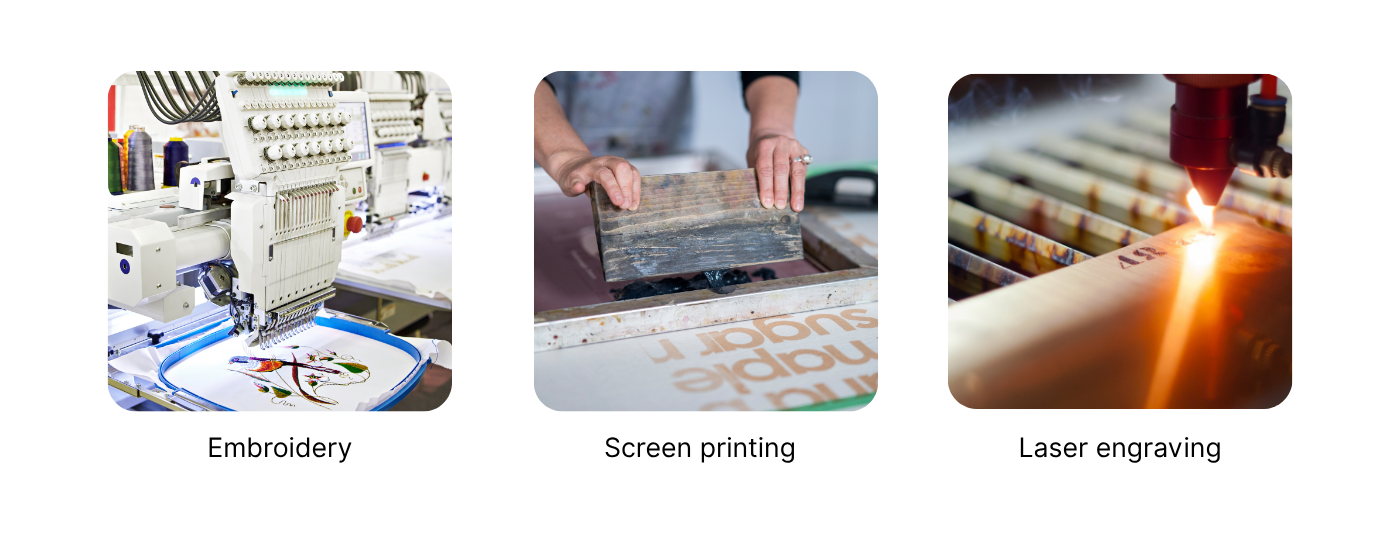
Choose a method that complements both the product and your brand identity:
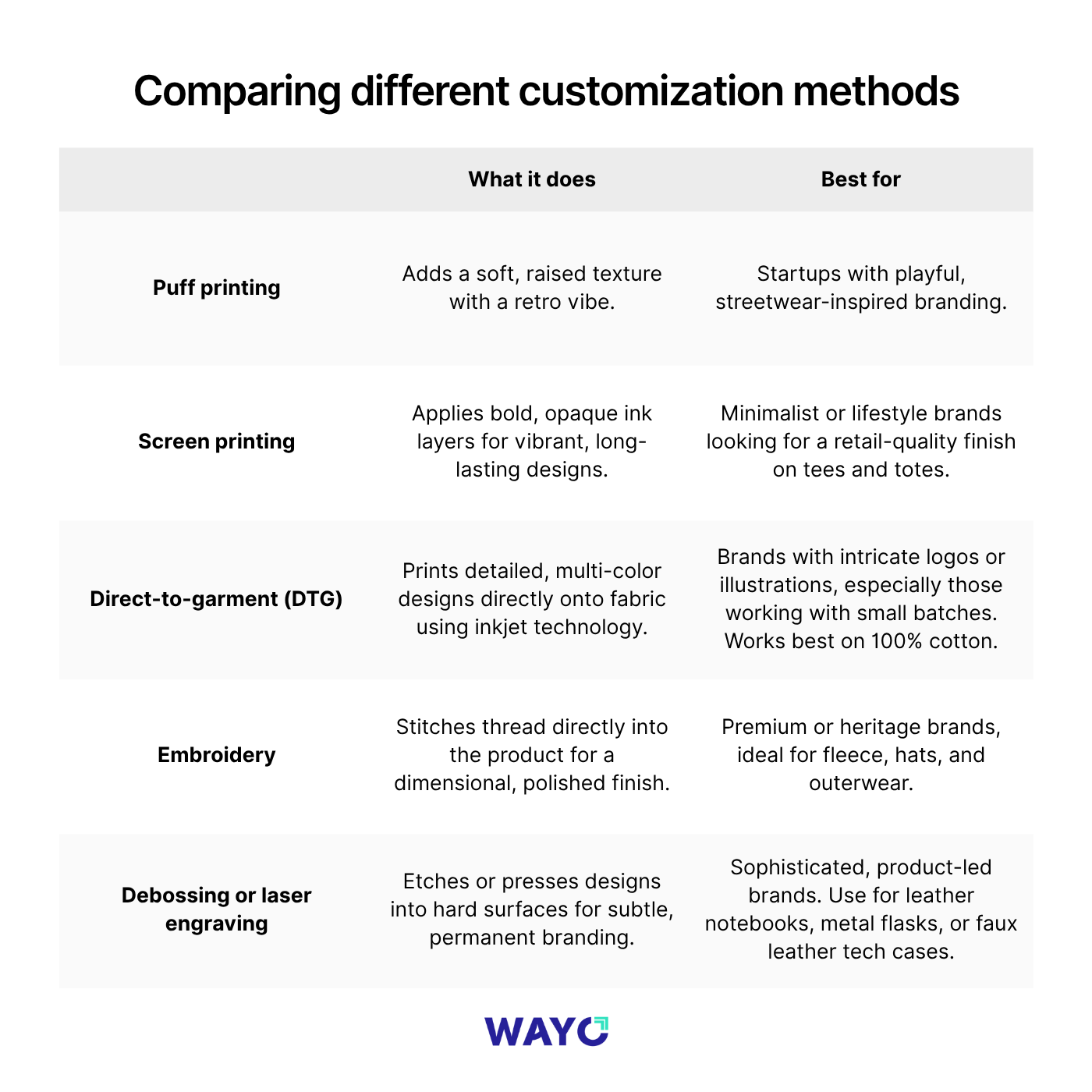
3. Use color with purpose
Color is one of the most immediate brand signals, but in merch design, it’s often either an afterthought or overly literal. Just because your brand uses blue doesn’t mean every hoodie, tote, or sticker needs to be Pantone 293 on a white background.
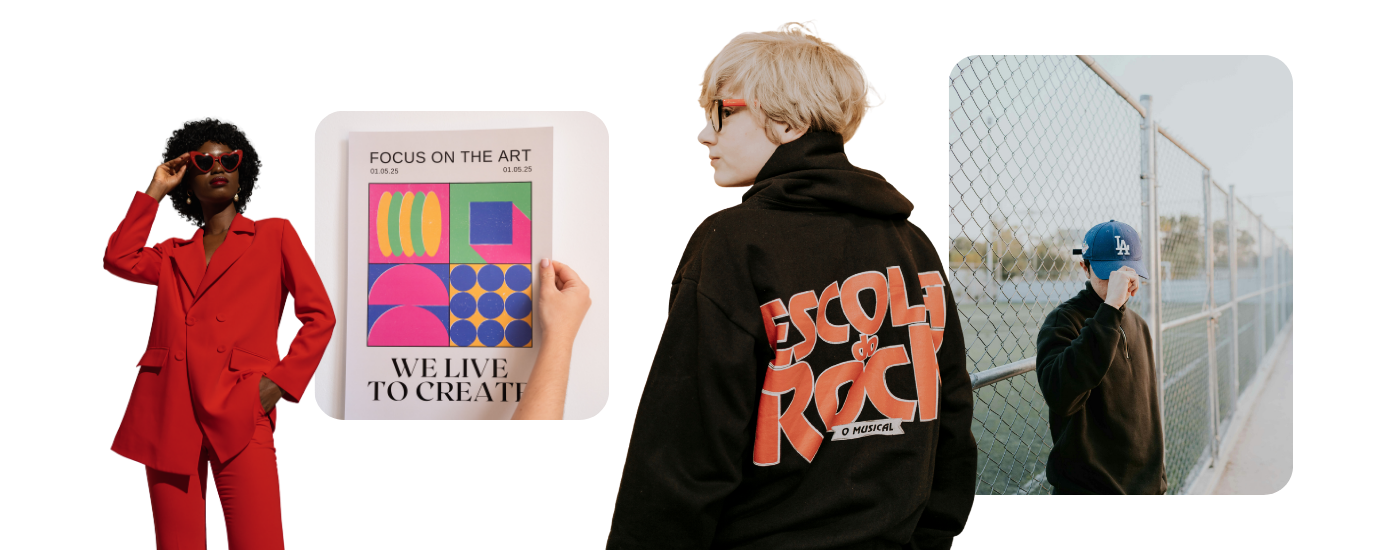
Here’s how to think about it:
- Build a merch-specific color palette: Pull from your brand’s primary and secondary colors, but don’t use them all. Choose two to three core tones that work across materials (textiles, metal, plastic, paper) and still feel cohesive when used together. If your main brand color is bold (e.g., electric orange), pair it with earthier neutrals or muted tones for balance.
- Don’t underestimate neutrals: Black-on-black embroidery, cream canvas with tonal beige print, or slate blue on charcoal are combinations that can feel elevated, wearable, and intentional. Meanwhile, bright contrast can be used sparingly to signal energy or draw attention to detail (think: zipper pulls, interior linings, or stitching).
- Match tone, not exact hex codes: Your brand’s digital color may not translate well onto fleece, enamel, or cotton. Instead of forcing an exact match, work with your vendor to find a physical swatch that feels right, even if the hex code shifts.
- Use color to suggest value: Matte finishes and deep, desaturated hues often convey a more premium feel than glossy, bright colors. If you want your brand to signal sophistication, avoid high-saturation, plasticky tones.
4. Prioritize fit and silhouette
Most people won’t remember your logo placement, but they’ll absolutely remember whether they looked good in that hoodie. Fit and silhouette are often overlooked in merch design, but they can be the deciding factor between something that gets worn once and something that gets worn out.
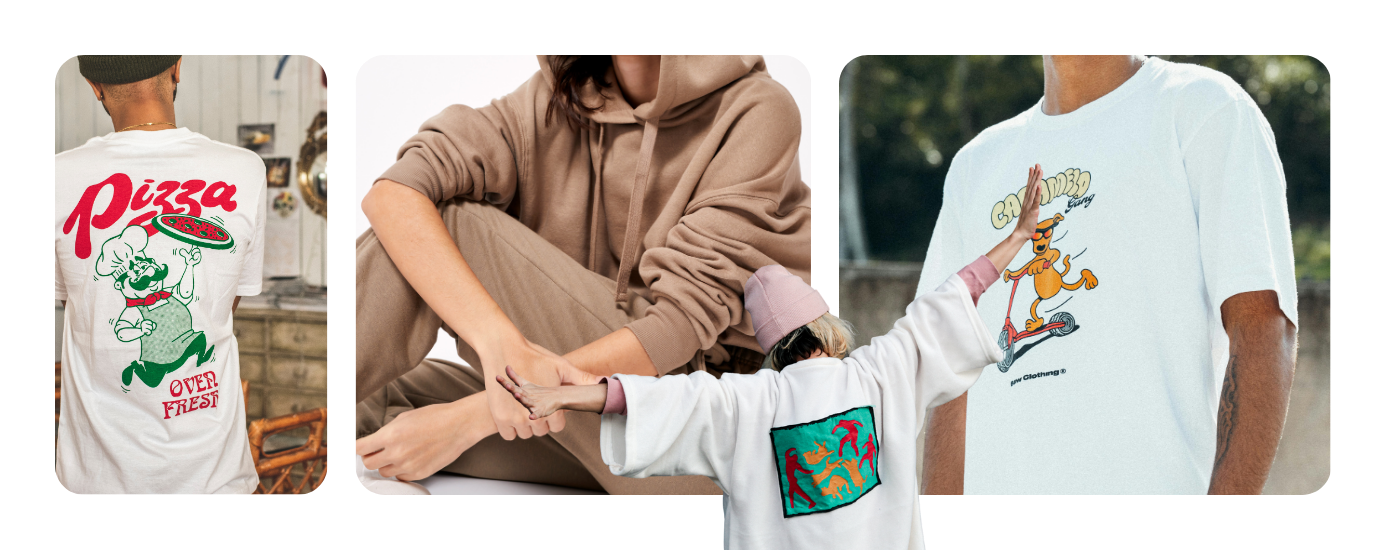
Here’s how fit choices can express brand identity:
- Oversized: Relaxed, drop-shoulder silhouettes are standard in streetwear and tech-forward startups. They suggest creativity, informality, and a sense of cultural fluency.
- Tailored/slim-cut: Fitted tees, structured jackets, and tapered joggers communicate polish and professionalism, making them great for B2B companies, financial services, or client-facing teams that want to maintain an elevated, minimal look.
- Boxy/classic cut: A throwback shape with wider shoulders and a cropped body. Often used in heritage brands or nostalgic merch drops.
And don’t assume one silhouette fits all. A unisex medium can feel wildly different across garments and vendors. That’s why it’s usually a good idea to start with a sample or smaller run before going forward with large production orders.
Learn more about different fabric weights and how they affect fit.
5. Design for longevity, not gimmicks
Loud colors, seasonal puns, and big, blocky logos might grab attention for a second, but they rarely stand the test of time. Longevity starts with restraint. Use these company merch design tips to hold up beyond the hype cycle:
- Use subtle branding: A logo on the sleeve hem or embossed on a zipper pull says far more than a center-chest billboard.
- Lean into timeless fonts and clean layouts: Avoid novelty typefaces or text-heavy layouts that will feel dated within a year. Stick to clean sans-serifs or modern serif fonts, well-spaced, and used with intention.
- Choose textural design elements: Tactile details like tonal embroidery, soft-touch screen print, woven patches, or contrast stitching add dimension without adding visual clutter. These elements create a premium feel and age gracefully.
- Skip trend-chasing colorways: Neon green might be having a moment, but will anyone want to wear it in nine months? Build your merch palette the way you’d build a product palette: grounded, versatile, and brand-cohesive.
- Watch your phrases: That cute slogan might hit today, but it may not still reflect your tone of voice next quarter. When in doubt, go with subtle messaging or internal references that feel specific but not cringey over time.
Ready to put these company merch design tips to action?
Great merch doesn’t need to scream your company name in neon. It just needs to feel aligned with your brand through material choices, thoughtful details, and a design that reflects your identity.
At Wayo, we make it easy to bring that vision to life. With endless customization options across materials, colors, and print methods, you can create something that feels uniquely you.


